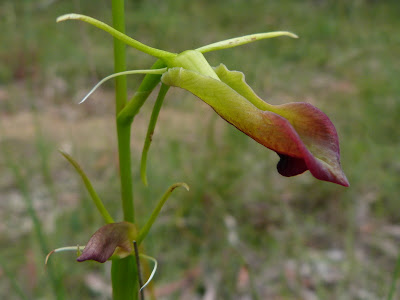Flight developed in bird-dinosaurs some 150 million years ago. It was an astonishing development, which has only happened four times in the history of life (among birds, bats, pterosaurs and insects) and which demanded some very profound adaptations. Accordingly, it seems counter-intuitive that within a few tens of millions of years some bird groups had already lost this marvellous ability; Hesperornis was a genus of several species of large flightless waterbirds whose wings had virtually disappeared by 80 million years ago.
Why should this have happened? Not carelessness, as Oscar Wilde might have suggested. It seems to me that there are two basic reasons why an adaptation might subsequently be lost, and I think that the existence of all flightless birds can be explained by one or the other of them.
Firstly if an early adaptation becomes an interference with a subsequent one, it may well be selected against. Penguins are a good case in point; once the ancestral penguin began using its wings to 'fly' through water, it had to make an evolutionary 'decision' to focus on one or the other.
 |
| Galapagos Penguin (Spheniscus mendiculus) 'flying' under water. |
Their short insulating plumage and flipper-like wings make flying in air impossible, but that's not nearly as important to them as being highly competent underwater.
 |
| Magellanic Penguin (Spheniscus magellanicus) Seno Otway, far southern Chile. |
Waterbirds from a series of totally unrelated families (which, unlike penguins, are still dominated by flying birds) have also taken the flightless option; these include grebes, auks, ducks and cormorants.
 |
Titicaca Grebe Rollandia microptera.
This, one of only two flightless grebes, is found almost exclusively on the huge Lake Titicaca,
though some birds are found from time to time on associated smaller lakes. |
 |
| Flightless Steamer Duck (Tachyeres pteneres), Isla Chiloe, Chile. Note tiny non-functional wings. |
 |
| Galapagos Cormorant (Phalacrocorax harrisi); again see the obviously non-flying wings. |
Another example of this principle is among the ratites - the giant flightless birds of the southern continents. Emus for instance (or their ancestors) presumably got progressively larger, perhaps to reduce the number of their predators, or perhaps to see over the grassland habitat - or both. Eventually the evolutionary question had to be answered - stop getting bigger, or give up flight? The ancestral Emu went for size. This raises another point - flightlessness removes the constraints on bird size. Emperor Penguins weigh over 45kg, Emus 55kg, Ostriches 150kg, and the extinct Elephantbirds of Madagascar and the Australian Mihirungs weighed around half a tonne!
 |
Emu (Dromaius novaehollandiae), Shark Bay, Western Australia.
The wings are not obvious in this windy situation, but are retained and function as balancers while running. |
The other situation in which a useful adaptation may be foregone is if the possessor finds itself in a situation where the pressures that led to it have disappeared. For instance if a bird arrived in a place where there were no enemies, then the cost of building and constructing the massive flight musculature may well not be worth while any more - especially if there was nowhere to fly to. This conundrum is encountered by birds arriving as castaways or storm refugees on a remote island, where being in the air might be more dangerous than being land-tied, with the hazards of being blown out to sea again. Such flightless island products are many - the New Zealand Kakapo is a parrot, the Dodo of Mauritius and the Solitaire of Rodriguez were pigeons, and the enigmatic Kagu of New Caledonia seems to be related to the South American Sunbitterns. Throughout the Pacific in particular there are numerous flightless rails.
 |
Lord Howe Island Woodhen (Gallirallus sylvestris) is a large flightless rail; again the small wings are evident.
(This is a wild bird, but virtually all the population is banded for study.) |
Just asking 'why?' can take us to all sorts of unexpected destinations, and we don't necessarily need to fly to get there.

















+Brindies+0110.jpg)






+Pindar+0908.jpg)


+Darwin+1208.jpg)






+Alerce+Andino+NP+1207.jpg)

+Kalbarri+0808.jpg)
+Ngaoundaba+Ranch.jpg)
















